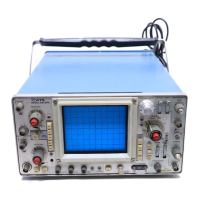TM 11-6625-2735-14-1
This input amplifier stage contains the CH 1 VAR
VOLTS/DIV control. This control provides continuously
variable (uncalibrated) vertical deflection factors between
the calibrated positions of the VOLTS/DIV switch. With
the VAR control in its calibrated detent (wiper at ground),
the output transistors of U120, whose collectors connect
to pins 5 and 9, are conducting; the output transistors
whose collectors connect to pins 6 and 8 are biased off.
Thus, the current available to the following amplifier stage
is that flowing from pins 5 and 9.
When the VAR control is rotated out of its calibrated
detent, the transistors whose collectors connect to pins 6
and 8 begin to conduct. The current they conduct is
robbed from the other output transistors. This causes two
things to occur:
1. The current flowing in the collectors of the tran-
sistors connected to pins 5 and 9 is less now than when the
VAR control was in its calibrated detent.
2. The current available to the following amplifier stage
is the algebraic sum of the currents in the collectors tied
together (i.e., pins 8 and 9 and pins 5 and 6). Since the two
collectors tied together have signals of opposite polarity,
the signal available to the following amplifier stage is less
than that when the VAR control was in its calibrated
detent. The component values selected for the variable
function provide a variable attenuation ratio of ap-
proximately 2.5 to 1. The Channel 1 Variable Balance
adjustment R110 adjusts for no trace shift in the display
when rotating the VAR control. The Channel 1 UNCAL
light indicates when the Channel 1 VAR control is out of its
calibrated detent. The components connected between
pins 2 and 3 of U120 provide high-frequency compensa-
tion for the stage.
Second Cascode Amplifier
The second amplifier stage in the Channel 1
Preamplifier circuit is U140. U140 is an integrated emitter-
coupled, push-pull, cascode amplifier similar to that used
in U120. It is used as a push-pull amplifier and has 2 mV
and 5 mV gain adjustments that determine the overall gain
of the Channel 1 Preamplifier circuit. The output signals
available to the next stage for amplification are taken from
pins 5 and 9 of U140.
3-6
The gain of U140 is determined by biasing the output
transistors connected to pins 6 and 8 to conduct more or
less current. As more current is conducted through the
transistors connected to pins 6 and 8, that much less is
conducted through the transistors connected to pins 5
and 9. The current conducted by the transistors con-
nected to pins 5 and 9 in the 2 mV position of the
VOLTS/DIV switch is approximately 2.5 times the current
conducted by the same transistors in all of the other
VOLTS/DIV switch positions. This results in increased
gain and a DC level shift at the signal output terminals of
U140. The VOLTS/DIV switch compensates for a shift in
the DC level by shorting out part of the common-mode
resistance (R157) when operating with 2 mV sensitivity.
Gain Switch Balance adjustment R135 adjust the DC
balance of the stage, so there is no baseline shift in the
CRT display when switching between the 2 mV and 5 mV
positions of the CH 1 VOLTS/DIV switch. The remainder
of the components connected between pins 2 and 3 of
U140 provide high-frequency compensation for the stage.
Third Cascode Amplifier
The third amplifier stage in the Channel 1 Preamplifier
circuit is a discrete component cascode amplifier made up
of Q172, Q178, Q182, Q184, and Q188. Q184 is a relatively
constant current source for Q172 and Q182. Q172 and
Q182 convert the input voltage signals into current signals
which are in turn converted back to voltage signals by
Q178 and Q188 respectively. R172 and R182 provide
thermal compensation and C172 and C182 AC-couple the
signal around R172 and R182 to reduce Miller effect. C175
and R175 are variable high-frequency compensation
adjustments while CR170, CR174, and RT170 offset com-
pensation changes associated with variations in ambient
temperature. As temperature increases, the value of
RT170 decreases. This results in a decrease in voltage
across CR170 and CR174. CR170 and CR174 are voltage-
variable capacitance semiconductors whose capacitance
increases with a decrease in reverse voltage across them.
Thus, CR170 and CR174 will provide more peaking at
higher temperatures. T178 is a toroid inductor that
cancels high-frequency common-mode signals
generated by the previous stages. The Channel 1 Vertical
Position Centering adjustment centers the range of
control of the Channel 1 POSITION control.
CHANNEL 2 PREAMP
General
The Channel 2 Preamp circuit is virtually the same as
the Channel 1 Preamp circuit. Only the differences
between the two circuits are described here. Portions of
this circuit not described in the following description
operate in the same manner as for the Channel 1 Preamp
circuit. Fig. 3-3 shows a detailed block diagram of the
Channel 2 Preamp circuit. A schematic of this circuit is
shown on Diagram 2, at the rear of this manual.

